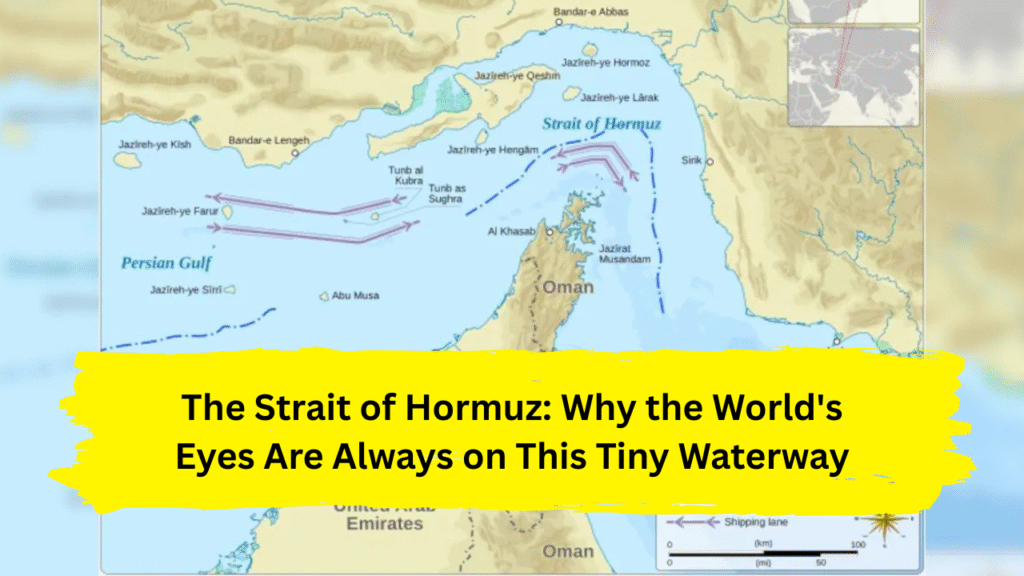Introduction
If you’ve been scrolling through X (formerly Twitter) in the last 24 hours, you’ve probably seen the Strait of Hormuz trending — and no, it’s not just another geo-political buzzword. This little waterway, just 21 miles wide at its narrowest point, holds the world’s oil economy in a chokehold. Sounds dramatic? It is — and for good reason.
Let’s break it all down in plain English and understand why Americans (and everyone else) are suddenly so concerned about this strip of ocean.
Geographic Importance
Where Exactly Is the Strait of Hormuz?
Imagine a funnel — that’s the Strait of Hormuz. It lies between Iran to the north and the United Arab Emirates and Oman to the south. It connects the Persian Gulf to the Gulf of Oman, and from there, the Arabian Sea.
Countries That Border the Strait
- Iran
- Oman
- United Arab Emirates (UAE)
These three countries form the physical backdrop of one of the world’s most politically volatile hotspots.
How Wide Is It Really? (Spoiler: It’s Narrow!)
At its narrowest point, the Strait is only 21 miles wide, but the shipping lanes themselves are even tighter — just 2 miles wide in each direction with a 2-mile buffer zone. That’s like driving two semi-trucks in opposite directions on a one-lane road with no median!
Global Oil Lifeline
How Much Oil Passes Through the Strait of Hormuz?
Around 20% of global oil — that’s roughly 17 million barrels a day — sails through this tiny corridor. Think about that for a second. If something happens here, the ripple effects can hit your gas tank within days.
Why Oil Prices Fluctuate Because of the Strait
Because the Strait is so vital, even a threat of conflict sends oil prices skyrocketing. That’s why any military action, a political standoff, or even a rogue tweet can trigger price hikes.
U.S. Interests in the Region
The U.S. might not be directly pulling oil through the Strait, but guess what? We still import oil, and global markets are like dominoes. If Saudi or Iraqi oil can’t get to Europe or Asia, the price of American oil goes up too.
History of Tensions in the Strait
The Iran-Iraq War and Tanker Attacks
Back in the 1980s, both Iran and Iraq targeted oil tankers in what’s now known as the “Tanker War.” The U.S. had to step in, reflagging Kuwaiti oil tankers under the American flag to keep them safe.
U.S. Naval Presence Over the Years
The U.S. Navy’s Fifth Fleet, stationed in Bahrain, has kept watch over the Strait for decades. They’re there to protect commercial traffic and deter any funny business from hostile players.
Recent Incidents and Near-Conflicts
From drone shootdowns to tanker seizures, things have gotten heated many times over the years — most recently in 2019 and 2023. Each time, the world holds its breath.
Current Situation (As of June 2025)
Why It’s Trending on Twitter Right Now
There’s a fresh buzz — possibly a naval standoff or diplomatic warnings between Iran and the U.S. over alleged provocations. Tweets are flying, analysts are debating, and everyone’s watching.
Recent Developments in Iran, U.S., and Gulf States
Rumors of missile placements, surveillance flights, and oil tanker interceptions have stirred the pot. The Biden administration is likely weighing options — from sanctions to fleet repositioning.
Potential Military Buildup or Diplomatic Moves
We might see a coalition of navies, UN statements, or even emergency OPEC meetings in response to rising threats.
Strategic Military Significance
Why the U.S. Navy Cares So Much
It’s simple: freedom of navigation. If one country can choke off global commerce at will, it’s a problem — not just for oil, but for international law.
Iran’s Control Over the Strait
Iran doesn’t own the Strait, but it borders it and has the power to mine or block it. That threat is enough to keep diplomats up at night.
Chokepoint Vulnerabilities and Risks
Imagine if L.A. or New York had just one highway in and out — that’s the Strait of Hormuz. A single missile, mine, or blockade could cause global chaos.
Impact on the Global Economy
Fuel Prices in the U.S. and Around the World
A 5-minute delay in the Strait could add dollars to the gallon at your local gas station. Think it’s far away? Think again.
How Businesses React to Strait Disruptions
Airlines, shipping companies, and even Amazon’s delivery routes can be affected. That “two-day shipping” might just turn into five.
Stock Market Ripples
Wall Street watches the Strait like a hawk. A sudden closure could sink energy stocks and rattle global markets.
Environmental Risks of a Conflict in the Strait
Potential Oil Spills
A hit tanker isn’t just an economic disaster — it’s an environmental one. Oil spills in this region could poison waters for years.
Impact on Marine Biodiversity
The Strait is home to unique coral reefs and marine life. Conflict here would devastate local ecosystems.
Diplomatic Efforts and Global Reactions
Role of the United Nations
The UN Security Council often convenes emergency meetings when things heat up here — but resolutions are slow, and action even slower.
Involvement of Other Global Powers (China, Russia, EU)
China depends heavily on Gulf oil, and Russia sees an opportunity to shift power. Expect lots of global chess moves.
What It Means for Ordinary Americans
Will Gas Prices Spike?
Probably. Even a perceived threat can drive up prices overnight.
Will This Affect Travel or Shipping?
Yes, especially international flights and cargo shipping. Even minor delays cost billions.
How Social Media Is Reacting
Top Tweets and Hashtags
#StraitOfHormuz #OilCrisis2025 and #NavalStandoff are currently trending. X users are debating, speculating, and meme-ing the crisis in real-time.
Misinformation and Viral Narratives
Always double-check what you read. Misinformation spreads faster than oil in the water during times like these.
What Comes Next?
Possible Scenarios in the Coming Weeks
- Escalation into direct conflict
- Diplomatic solution with naval escorts
- Temporary disruption of oil shipments
What Experts Are Predicting
Most analysts believe a full-on war is unlikely but agree the tensions will remain high. Markets and governments are preparing for the worst — just in case.
Conclusion
The Strait of Hormuz might look like just a narrow strip on the map, but it’s one of the world’s most important and dangerous flashpoints. As tensions flare once again, the U.S. — and the world — watches closely. Whether you’re filling up your car, investing in stocks, or just following global politics, this tiny waterway has a massive impact on your daily life.
FAQs
1. What countries control the Strait of Hormuz?
Iran and Oman share territorial waters around the Strait, but international law guarantees passage.
2. Why is the Strait of Hormuz so important to the U.S.?
Because global oil flows through it — and disruptions affect U.S. markets, military strategy, and diplomatic relations.
3. How could conflict in the Strait affect global oil prices?
Any conflict or perceived threat can send prices skyrocketing due to supply chain concerns.
4. Is the Strait of Hormuz international waters?
It includes both territorial waters and international shipping lanes protected by maritime law.
5. Has the U.S. ever fought over the Strait of Hormuz?
Not directly, but it has engaged in naval operations and skirmishes to protect commercial vessels.
Also Read: Latest Trending News


